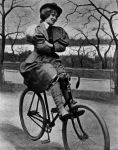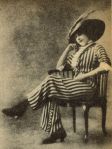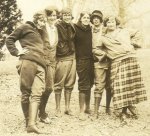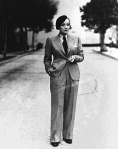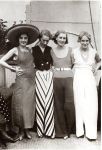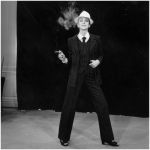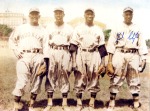It’s FRIDAY FASHION FACT time! Last week I gave an overview of the history of trousers (read here.) Today I’m going to talk about how pants became womenswear in the western world. While there were rare cases of women wearing trousers in the ancient world, it was not until relatively recently that women wearing trousers became an acceptable fashion.
In the early 1850s, there was a very small group of women who advocated for a bifurcated (aka, divided in two) garment for women. This was during the early days of the crinoline trend, when layers of petticoats made skirts extremely heavy and restricting. Activist Libby Miller promoted wearing full, loose trousers cinched at the ankles, similar to the Turkish style. She introduced the garment to Amelia Bloomer, editor of the first women’s newspaper, The Lily. Bloomer loved the garment, wore it often, and advocated for it in her newspaper. Thus, these loose trousers were dubbed “bloomers.” However, once the cage crinoline was created, Bloomer declared that was change enough, and so abandoned the bloomer trouser. The garment did not disappear completely, though. A modified version became a popular undergarment, allowing women to adopt reform without shocking polite society.
As technology and society developed towards the end of the 19th Century, there were many who recognized that women’s fashion needed to shift along with it. In the early 1890s, the bicycle became extremely popular, as the “safety bicycle” was invented, and costs came down. It allowed women an independence and freedom they had yet to possess. Yet cycling in a long skirt was extremely difficult, and so the newly formed Lady Cyclists’ Association promoted the Bicycle Suit, a menswear inspired garment with full, knee-length trousers. They became very popular, yet were still considered shocking by many, and scandalous when worn outside of cycling.
It wasn’t until the 1910s that it became somewhat acceptable for women to wear trousers outside of active wear. During World War I, when nearly all the working-age men were off fighting, women took their place in the working world. Those who had jobs in factories, and other such hard labor positions, altered their husbands trousers to wear while working. This was both for the
freedom of movement trousers allowed, as well as to save money and preserve their skirts for social situations. Even during this time, a woman wearing trousers in public was still considered scandalous. When the war ended, there were a bold few who were not so quick to give up the freedom which trousers allowed.Throughout the 1920s and 30s, it became increasingly common for a woman to wear trousers for leisure. Women more commonly participated in sports, and the rise of the aviator meant an increasing number of female celebrities seen wearing trousers. This was also the case with the rise of the Hollywood Movie
Star, with actresses such as Marlene Dietrich and Katherine Hepburn frequently photographed in trousers.When World War II hit, the situation from WWI repeated itself, with women entering the workforce and wearing their husband’s altered clothing. This time, however, it occurred to an even greater extent, with vast material shortages and clothing rations. This solidified trousers position in women’s wardrobes. Though they were still only accepted in casual situations, they continued to increase in popularity throughout the next several decades. There was an additional boost in the 1960s when Yves Saint Laurent introduced the formal trouser. Despite the development, though, women’s trousers are still mainly acceptable only in more casual situations to this day. As we know, though, fashion is constantly
changing.Want to learn more about the history of women wearing pants? Check out these books:
Women in Pants, by Catherine Smith and Cynthia Greig
100 Years of Fashion, by Cally Blackman
Have a question about fashion history that you want answered in the next FRIDAY FASHION FACT? Just click the ASK button at the top of the page!
Galleries
black widow | homecoming
“that you, is it, nat? twice as tough and twice as smart?”
The thousand-yard stare is a phrase coined to describe the limp, blank, unfocused gaze of a soldier, but the symptom it describes may also be found among victims of other types of trauma. A characteristic of post-traumatic stress disorder, the despondent stare reflects dissociation from trauma.
Bletchley Park
World War II code-breaking enclave in the English countryside of Buckinghamshire.Thousands of women were employed here to decipher encoded German signals and secret communication sent between Nazi generals.
Far from being a group of experienced decoders, however, the estate’s recruits mainly consisted of young teenage military personnel, a smattering of crossword whizzes who had been able to compelete the Daily Telegraph’s puzzle in less than 12 minutes, and numerous 18-year-old girls plucked from their quiet home towns.
“It was the middle of the war when I recieved a call saying I was to go into war work to support Britain’s efforts from home,” explains 88-year-old Margaret Bullen, a machine wire operator who served from 1942 until the end of the war. A letter from the Foreign Office then arrived saying I had an interview – but I had no idea what it was for, and two weeks later, I was told I’d be off to Bletchley.”
“Before starting work we were told to sign the Offical Secrets Act, which was a rather frightening experience for someone as young and naive as I was,” says 90-year-old Becky Webb, who joined the war effort at age 18 in 1941. “I had no idea how I’d comply with it!”
“I never knew what any of my coworkers were doing, and vice cersa and my parents never knew a thing of it” reflected Ruth Bourne who also joined the war effort at age 18.
Despite not knowing much about what their work was or what it was being used for, what these women did was crucial. Intelligence produced at Bletchley shortened the war by two to four years, and without it the outcome of the war would have been uncertain.
Photo of the Brooklyn Royal Giants taken in 1939, and autographed by Zack Clayton. The team played from 1905 – 1942, as an independent team, part of the Eastern Colored League, as well as the Negro National League. Article is from August 13, 1939 edition of the Brooklyn Daily Eagle.
anon asked: les mis sets or poto sets
Steve + bruised and battered.
Jupiter Ascending : expand your universe.
